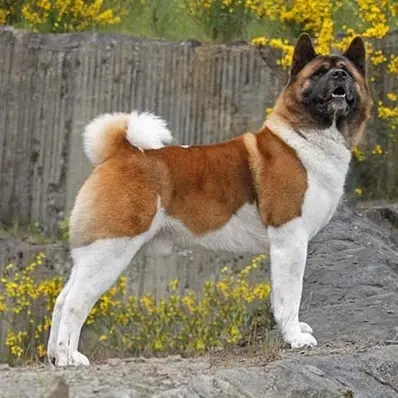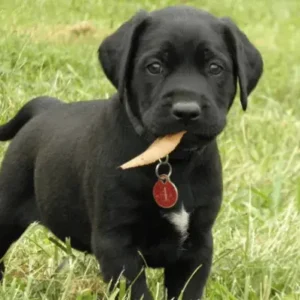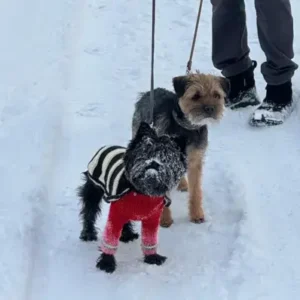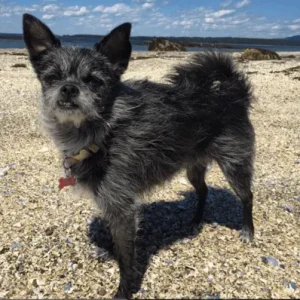Akita History/Origin
The Akita represents Japan’s contribution to the ancient spitz-type canine lineage, originally developed in the early 17th century within the Akita prefecture of northern Japan. According to legend, the breed’s roots trace back to a nobleman banished to this region, where he promoted the breeding of a robust hunting dog among local barons.
These efforts led to the creation of the Akita, known for its prowess in hunting wild boar, deer, and the formidable Yezo bear in packs.
Historically, these purebred dogs were reserved for the imperial family and nobility, later becoming esteemed family guardians worldwide. Embedded in Japanese culture, they are revered symbols of happiness and longevity, often gifted as figurines upon the birth of a child. One of the most famous Akitas, Hachiko from the 1920s, remains an enduring symbol of loyalty in Japan.
Hachiko- Source: The Asahi Shimbun
Despite facing near-extinction at various points, the Akita’s survival was ensured by the establishment of a Japanese National Breed Club in 1927. Helen Keller played a pivotal role in introducing this do to the United States after receiving one as a gift during her visit to Japan.
The breed gained popularity in America post-World War II when returning servicemen brought them back from the Pacific. The American Kennel Club officially recognized the Akita under Working Group and entered its Stud Book in 1972.
Akita Personality
The Akita is one of the dog breeds which is bold and willful, with a natural wariness of strangers but deep loyalty to their family. They are affectionate and playful with their loved ones, enjoying active participation in daily activities. Despite their imposing demeanor, they have a playful side and often carry toys and household items around.
- Temperament
The Akita is characterized by a bold and independent temperament. These dogs are naturally wary of strangers but extremely loyal and affectionate towards their family members. They are known for their alertness, intelligence, and courage, which historically made them excellent guardians and hunters in Japan.
- Potential Issues
The Akita breed presents several potential challenges. They can be aggressive towards other dogs, especially those of the same sex, requiring early socialization. Their strong-willed nature demands consistent training to establish boundaries and proper behavior.
They are known for being mouthy and may carry items around, potentially leading to destructive behaviors if not managed. Their protective instincts can turn into aggression if not properly channeled. Therefore, owning an Akita requires dedication to training, socialization, and providing ample exercise to ensure they thrive in a home environment.
Akita Physical Appearance
The Akita is a large breed, heavily boned spitz-type dog that is sturdily built and well-balanced. Its head is broad and triangular-shaped. It features small eyes and erect ears. These ears are carried forward, nearly in line with the back of the neck. This configuration is a distinctive characteristic of the breed.
- Size
The Akita is a large and powerful breed, typically standing between 26 to 28 inches tall at the shoulder. They are robust dogs, weighing between 85 to 130 pounds. Their size and muscular build reflect their history as formidable hunters and guardians in Japan.
- Coat color
The Akita comes in several coat colors, including black, fawn, red, white, and brown brindle according to breed standards. Their undercoat is typically soft and thick, differing in color from the shorter outer coat. This double-layered coat serves to insulate them against harsh weather conditions, particularly in cold mountainous regions, providing both warmth and protection.
Akita Gender Differences
While differences exist between male and female Akitas, it’s crucial to avoid gender stereotyping their personalities and behaviors. Both genders can demonstrate distinct traits influenced by their temperament and upbringing rather than just their gender.
- Size
Male Akitas reach heights of 26-28 inches and weigh 105-110 pounds. Females are slightly smaller, standing 24-26 inches tall and weighing 75-80 pounds.
- Temperament
Male Akitas starts as friendly and playful puppies but grow aloof and territorial as they mature. They can be dominant and challenging, requiring an experienced owner who can assert authority early on.
Females are initially playful and affectionate but become more aloof with age, showing strong loyalty to their family. They may exhibit same-sex aggression, making it difficult to pair with other female dogs in the household, often necessitating careful management or rehoming to avoid conflict.
Akita Feed/Nutrition
Feed your adult dog 3 to 5 cups of high-quality dry food daily. Remember, the amount can vary based on your dog’s size, age, metabolism, and activity level. Just like people, dogs have individual needs; an active dog may require more food than a less active one.
Choosing high-quality dog food is crucial as it provides better nutrition, meaning you’ll need less to satisfy your dog’s dietary needs. Consult your veterinarian to determine the best diet for your dog. Adding bananas as an occasional treat can be a healthy, nutrient-packed option for your dog.
Akita Health
Akitas are generally robust, yet like all breeds, they are susceptible to specific health conditions:
- Hip Dysplasia: Akitas, like many large breeds, are prone to hip dysplasia, a condition where the hip joint doesn’t develop properly, leading to pain and mobility issues. Diagnosis often involves X-rays to assess joint health, and affected dogs should not be used for breeding to prevent passing on the genetic predisposition.
- Canine Gastric Torsion: A serious and potentially life-threatening condition for Akitas, bloat occurs when the stomach fills with gas and twists on itself. This can rapidly progress to shock without immediate veterinary intervention. Owners should be vigilant for symptoms like a distended abdomen, restlessness, and unproductive attempts to vomit, seeking emergency care promptly.
- Hypothyroidism: A common endocrine disorder in Akitas, hypothyroidism affects the thyroid gland’s ability to produce sufficient hormones. Symptoms include weight gain, lethargy, and skin problems. Treatment involves lifelong medication to regulate thyroid levels, along with dietary adjustments to manage weight and coat health.
- Progressive Retinal Atrophy: A hereditary eye disease affecting Akitas, PRA initially manifests as night blindness and progresses to complete vision loss. Regular veterinary check-ups and genetic testing can help identify carriers early, though there is no cure for PRA once it develops.
- Sebaceous Adenitis (SA): A chronic skin condition unique to certain breeds, including Akitas, SA causes inflammation and destruction of sebaceous glands, leading to dry, scaly skin and hair loss. Diagnosis often requires skin biopsies, and treatment focuses on managing symptoms with medicated baths, supplements, and sometimes immune-modulating medications.
- Cancer: Cancer is a significant concern for Akitas, with symptoms including abnormal swelling, sores that do not heal, bleeding from any body opening, and difficulty with breathing or elimination. Treatment options for cancer in Akitas include chemotherapy, surgery, and medications, depending on the type and severity of the cancer diagnosed. Regular veterinary check-ups and early detection are crucial for managing and treating cancer effectively in Akitas.
Each of these conditions underscores the importance of regular veterinary care and responsible breeding practices to minimize health risks.
Akita Care and Grooming
Grooming an Akita requires regular attention due to their heavy shedding. Weekly brushing helps manage loose hair and keeps their coat in good condition. Baths every three months, or more frequently if they get dirty, are recommended.
Regular nail trimming and weekly ear checks are also important to prevent health issues. Starting grooming routines early and making them a positive experience will help your Akita get used to the process.
Exercise is just as vital for Akita’s well-being. These powerful dogs need daily exercise to stay healthy and happy. A brisk walk or play session of at least an hour a day will help burn off energy and keep them fit.
Engaging in activities like obedience training, agility, or hiking can also provide mental stimulation, which is key to preventing boredom and associated behavioral issues.
Starting grooming and exercise routines early in Akita’s life and ensuring they are positive experiences will help them grow accustomed to the process as they mature into adulthood.
Additionally, training your dog to stay from a young age will improve their obedience and make them more manageable in various situations.
Akita Rescue Groups
Breed-specific rescue groups dedicated to Akitas work tirelessly to provide a second chance for these loyal and noble dogs. They rescue dogs from shelters, neglectful situations, and owners who can no longer care for them. Through foster care and adoption programs, these groups ensure each dog receives the necessary medical care, training, and socialization. Their ultimate goal is to place Akitas in loving, permanent homes where they can thrive and live happily.
Akita Price
The price of an Akita typically ranges from $1000 to $3000, depending on factors such as breeder reputation, pedigree, and location.
When buying an Akita, choose a reputable breeder who prioritizes health and well-being. Ensure the breeder provides health screenings and proper socialization. Puppies should be raised in a clean, nurturing environment. Be prepared for the responsibilities of owning an Akita, including training and socialization.
Interesting Facts
- Originally called “snow country dogs,” Akitas originated from a snowy, rural mountain region of Japan. They were traditionally used for hunting boar, elk, and the small Yezo bear. Today, there is a dedicated museum in the city of Odate celebrating the breed.
Museum in Odate- Source: itelhas.com
- One famous example is the film “Hachi: A Dog’s Tale,” based on the true story of a loyal Akita named Hachiko in Japan.
Hachi: A Dog’s Tale- Source: IMDb
- They appeared in the breed judging show in 2023.
Best For
Akitas are best for experienced dog owners who can provide firm training and socialization from a young age. They are loyal, and protective, and make excellent companions for those who understand their independent and strong-willed nature. They are family dogs.
Top Names
| Male Akita Names | Female Akita Names |
| Kuma | Yuki |
| Taro | Hana |
| Riku | Suki |
| Kenji | Akira |
| Hiro | Mika |









 Hachiko- Source:
Hachiko- Source: 

 Fawn and White Akita- Source:
Fawn and White Akita- Source:  Brown and White Akita- Source:
Brown and White Akita- Source:  White Akita- Source:
White Akita- Source: 
 Museum in Odate- Source:
Museum in Odate- Source:  Hachi: A Dog’s Tale- Source:
Hachi: A Dog’s Tale- Source: 






